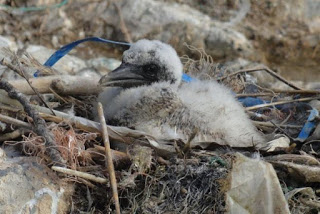1. Zinke Recommends Removing Protections from 10 National Monuments
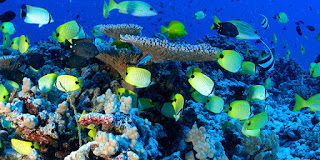 Interior Secretary Ryan Zinke is recommending shrinking the size of four western national monuments and opening up three marine monuments to fishing. Ten monuments would be managed differently in order to allow “traditional uses” such as “grazing, logging, coal mining and commercial fishing.” Congress can easily make changes to national monuments through legislation, but presidents rarely change monument boundaries. The fate of 11 monuments, including the Papahanaumokuakea reserve off of Hawaii, is unclear.
Interior Secretary Ryan Zinke is recommending shrinking the size of four western national monuments and opening up three marine monuments to fishing. Ten monuments would be managed differently in order to allow “traditional uses” such as “grazing, logging, coal mining and commercial fishing.” Congress can easily make changes to national monuments through legislation, but presidents rarely change monument boundaries. The fate of 11 monuments, including the Papahanaumokuakea reserve off of Hawaii, is unclear. ———————————————–
2. Secret Social Lives of Octopuses
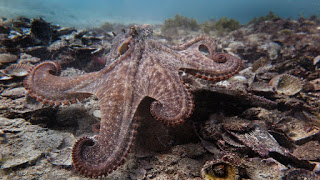 Octopuses have always been seen as loners who only come together to mate, but that view has now changed thanks to some new observations. A place dubbed “Octlantis” has been found in Australia where 15 “gloomy” octopuses reside in close proximity. There residents have “been seen to congregate, communicate and even evict one another.” They have even constructed a series of dens out of clam and scallop shells leftover from meals.
Octopuses have always been seen as loners who only come together to mate, but that view has now changed thanks to some new observations. A place dubbed “Octlantis” has been found in Australia where 15 “gloomy” octopuses reside in close proximity. There residents have “been seen to congregate, communicate and even evict one another.” They have even constructed a series of dens out of clam and scallop shells leftover from meals.———————————————–
3. Parasitic Sea Lice Plague Salmon Farms
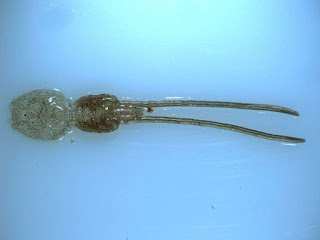 Salmon farms around the world are battling parasitic sea lice, which burrow into the salmon, killing some and making others unsuitable for sale. The lice have infested farms in the United States, Canada, Scotland, Norway and Chile. The problem costs the salmon farm industry $1 billion a year. Solutions being tried include bathing the salmon in warm water to remove lice, zapping lice with a laser, breeding for genetic resistance, and using “cleaner fish” to eat the lice.
Salmon farms around the world are battling parasitic sea lice, which burrow into the salmon, killing some and making others unsuitable for sale. The lice have infested farms in the United States, Canada, Scotland, Norway and Chile. The problem costs the salmon farm industry $1 billion a year. Solutions being tried include bathing the salmon in warm water to remove lice, zapping lice with a laser, breeding for genetic resistance, and using “cleaner fish” to eat the lice.
———————————————–
4. Marine Plastics Found in Seabirds
Scientists who collected the results of studies of 34 species of seabirds found that 74 percent had ingested plastic. Species affected included albatrosses, petrels, and shearwaters. The full impact of plastic on seabird populations around the world is unknown. Millions of tons of plastic are dumped into the oceans every year.
———————————————–
5. Rising Tide Against Drilling
 A swelling coalition of East Coast businesses, governors, and legislators from both parties hope to halt a Trump administration plan to open the Atlantic coast to oil and gas exploration. In a recent letter to Interior Secretary Ryan Zinke, they argued that $95 billion in economic activity and 1.4 million jobs depend on a healthy coastline, including hotels, restaurants and recreational and commercial fishing. They join the voices of environmentalists, who have long opposed seismic testing and drilling due to its negative impact on marine life.
A swelling coalition of East Coast businesses, governors, and legislators from both parties hope to halt a Trump administration plan to open the Atlantic coast to oil and gas exploration. In a recent letter to Interior Secretary Ryan Zinke, they argued that $95 billion in economic activity and 1.4 million jobs depend on a healthy coastline, including hotels, restaurants and recreational and commercial fishing. They join the voices of environmentalists, who have long opposed seismic testing and drilling due to its negative impact on marine life.
———————————————–
6. Half of Sharks in Arabian Sea Threatened
A recent assessment of sharks, rays, and chimaeras in the Arabian Sea has found that more than half are at risk of extinction. The 2107 IUCN Red List survey concluded that another 27 of the region’s 78 species could be threatened soon. “The results are a call to action and highlight the urgent need for regional cooperation in research and policy efforts,” says Shaikha Al Dhaheri of Abu Dhabi’s environmental agency.
———————————————–
7. Can Coral Researchers “Accelerate Evolution”?
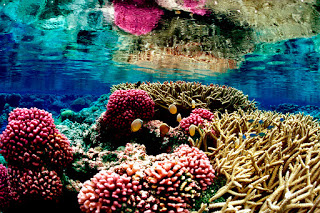 In the face of massive die-offs of coral reefs due to heat stress, a few researchers are pursuing desperate measures. Efforts include genetic banking and breeding the most resilient corals in the lab for replanting. The scientists warn that more drastic solutions such as selective breeding or infusing coral with heat-resistant genes may be needed. Big questions remain about whether these approaches are feasible, ethical, or sufficient to keep up with the scale of changes in the ocean.
In the face of massive die-offs of coral reefs due to heat stress, a few researchers are pursuing desperate measures. Efforts include genetic banking and breeding the most resilient corals in the lab for replanting. The scientists warn that more drastic solutions such as selective breeding or infusing coral with heat-resistant genes may be needed. Big questions remain about whether these approaches are feasible, ethical, or sufficient to keep up with the scale of changes in the ocean.
———————————————–
Be sure to “LIKE” http://facebook.com/SeaSave to ensure our “Week in Review” is delivered to your newsfeed every Friday.
Sea Save Foundation is committed to raising awareness of marine conservation. The Week in Review is a team effort produced by the Sea Save staff to provide a weekly summary of the latest in marine research, policy, and news.

